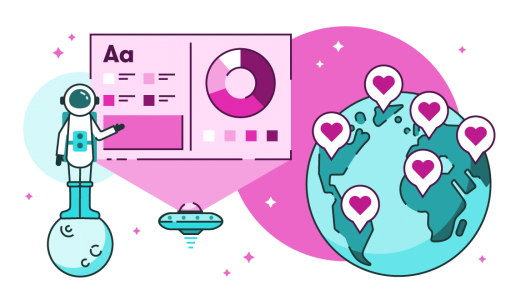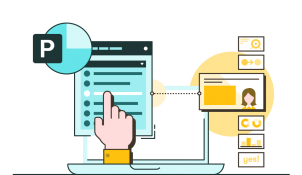The goal of presenting inclusively is to make sure none of your audience are excluded from your presentation due to their background or abilities. Even if you think you know your audience – many people could be experiencing invisible disabilities or situational limitations that could affect their ability to participate. But taking steps to ensure your presentation is inclusive and accessible is likely to benefit everyone!
The rise of computers, the internet, and new technologies means we have better and more independent access to information and communication than ever before. Online presentations mean our audience might not even need to leave their own home to participate, and people can watch presentation recordings at a time and pace that suits them. However, with these new technologies comes new barriers. In a small classroom environment or a meeting room, the teacher or presenter could try to ‘accommodate’ people with disabilities if they are made aware of them by, for example, providing handouts in larger print or pausing to allow the audience to ask questions. When we’re online, we have less control over the environment. And even if we are in person, often audiences are large, and many disabilities are invisible or poorly understood. A person experiencing a disability shouldn’t need to speak up to get the adjustments they need. As presenters, once we begin to recognise and understand potential barriers for our audience we can remove them.
We’ve written a few blog posts about improving accessibility in presentation design, so today we wanted to focus on how to actually present your decks more inclusively. Let’s dive right in!
Use plain language
There’s been loads of research on the benefits of using plain language, but the term is often misunderstood. There’s a common myth that using plain language means dumbing down content and people often worry that this makes their content inappropriate for audiences of skilled professionals or academics. However, plain language is beneficial for everyone.
So, what does using plain language mean? Writing in plain language means simplifying sentences and removing unnecessary jargon to help you get your message across clearly and concisely. Even if you’re presenting to an audience of experts, there are many people who may benefit from you using plain language – such as people who have dyslexia, who speak English as a second language, or who might be struggling to focus due to various situational reasons.
Of course, the language you use will be different depending on the audience you’re addressing. Writing in plain language correctly means identifying your audience and taking that into consideration when choosing what level of vocabulary to use. You can then make sure your message is communicated in full, but in a way that’s clear and easy to remember. If you don’t know your audience, their reading age could be lower than you think.
And finally, make sure that the plain language you use on your slides is reflected in your speech! If you want to learn more about plain language, read this really great article from Hoa Loranger.
Connect with your audience using inclusive language
Whilst plain language will make your content easier to understand and remember, there’s more to consider when writing your script. Firstly, make sure to avoid unconscious biases, slang and expressions that could discriminate groups of people based on ability, gender, or socioeconomic status. For example, opt for ‘they’ ‘them’ or ‘their’ when a person’s gender is unknown or unclear, and replace gendered terms like ‘salesman’ with gender neutral terms like ‘salesperson’ instead.
You should also pay attention to how you talk about any important visuals on your slide. Your audience may struggle to see your slides clearly either due to visual impairments, or situational factors like sitting at the back of the room or using a low-quality computer screen. Make sure to describe visuals in a way that means your audience members can get the equivalent information and context just from listening to your presentation. When talking about something like a chart or diagram, don’t refer to elements only by their colour or position – e.g. ‘the red line’ – as people with certain visual impairments such as colour vision deficiency may not be able to understand.
Give your audience time to think
The next tip is to carefully consider the pace of your presentation. When people watch recorded videos they can usually adjust the speed or pause and rewind when they need to. However, as a live presenter you need to find a balance between making sure your audience can keep up with what you’re saying and going quick enough to prevent your audience disengaging. Practice your presentation out loud, paying particular attention to how quickly you’re speaking.
Another great technique is to use strategic pauses to make sure that you give your audience enough time to think and process the information that you’re presenting. Strategic pauses, if only for a second or two, are an important part of helping your audience better understand what you’re saying. Though it might feel awkward to stop speaking for a couple seconds when you’re presenting, it doesn’t sound awkward to an audience. Practice pausing and the end of every slide and when you introduce visual information like charts and graphs that your audience may need time to digest.
Use accessibility tools
These days, we’re lucky enough to have lots of tool available to help us present inclusively. If you’re presenting in person, check to see if you can provide live captions. PowerPoint can produce automatic captions as you present in the same language you’re speaking, or as subtitles translated to another language.
If you’re presenting online, check your meeting or live event settings to make sure captions and/or transcription are enabled. Teams also allows you to add live translation into many other languages with Teams Premium.
If you’re sharing a PowerPoint presentation in a Teams meeting, instead of using the standard share screen button, try sharing your presentation using PowerPoint Live. You can either select the file under the share button in the Teams meeting or, if your presentation is already open, select the ‘Present in Teams’ button. As a presenter this gives you access to lots of meeting tools to engage with your audience. It can also improve the viewing experience for people with slower internet connections. This feature allows individual audience members to interact with your presentation and personalise the experience to suit their needs. For example, they can switch to a high contrast view, use screen readers on the slide content, click on hyperlinks to get access to additional context, and even translate slide text into 19 languages! One feature of PowerPoint Live is that audience members can navigate through your presentation independently. However, if you’ve got a carefully crafted deck, you probably want your audience following along with you rather than jumping ahead. So, you can turn this feature off using the Private View toggle.
Finally, consider how and when you’ll allow audiences to ask questions during your presentation. Again, there are tools to help you. Providing the audience with a way to submit questions using a chat feature can help people who might not feel comfortable speaking up or who may struggle to concentrate if they have an unanswered question floating around their head. For larger webinars it may help to have a facilitator in the chat who can help answer questions whilst you’re presenting or filter questions to ask you later.
Keep your presentation focused
Another consideration if you’re trying to present inclusively is how to maintain your audience’s attention and focus. There are several factors that could influence your audience members’ focus including conditions like ADHD or anxiety, and situational factors like being in a hot conference room for too long. Regardless of what might impact our ability to focus, generally most adults are unable to sustain attention on one thing for more than 20 minutes. However, we do have the ability to ‘refocus’ on the same thing. The key with presentations is to keep providing stimuli so people keep refocusing on what you’re saying.
Firstly, keep your presentation content focused. It’s easy to cram loads of information into a presentation, especially if you’re passionate about the topic. However, you should review your slides to see if there’s any content you could reduce or cut out completely. The less content you have, the easier it is for everyone to pay attention! Consider what key points you want your audience to take away with them and try to simplify complex ideas into bitesize chunks. Remember you can always provide material or links for further reading after the presentation for people who want to learn more. A good question to ask is ‘Is this essential or is it just nice to know?’. Only essential info makes it into the deck!
Once you’ve focused your presentation content, you can use animation to draw your audiences’ attention to information as you present. By introducing separate ideas on individual mouse clicks, you make sure that the audience doesn’t get distracted by reading ahead, and stays focused on you as the presenter and what you’re saying. Animation can be a powerful tool to bring visuals to life or demonstrate concepts or processes. But if you’re going to use animation, make sure it’s purposeful and not an unnecessary distraction. You should also consider the speed of your animations. If they are too fast or too subtle, the audience could miss it entirely, especially if they have a slower internet connection. Make sure your visuals still tell the story when static after the animation has finished playing.
And finally, avoid fast flashing GIFs and videos. Anything flashing more than 3 times a second can trigger seizures, so make sure to review any videos you’re using. If you’re unsure, you can find websites online which review videos to determine if they contain flashing that could trigger seizures.
Give your audience breaks
A great way to sustain attention is to mix up the formats throughout your presentation and give them a break from listening to you! This could be as simple as a 5-minute comfort break in longer sessions. It could also include getting your audience engaged using online feedback tools like polls. PowerPoint has recently released a Forms Present mode. This allows you to insert a live poll directly into your presentation. The audience can scan a QR code and see the results of the poll live in the presentation without you having to exit Show Mode, which is really cool!
Share your slides and presentation recording
Though you might not want your audience flicking back and forth through your slides whilst you’re presenting, it may be helpful to make the material you’re sharing available to attendees who need it either in advance of or following your presentation.
Your first option is to provide the actual slides. This will allow people to look through at their own pace before your presentation and/or use a screen reader to access the content. If you don’t want to do this by default, you can let your audience know slides are available on request for those who need them. You may need to create a simpler version of your PowerPoint without animations and with more explanatory text to share in this way. An alternative is to create a custom-made handout – check out this presentation handouts blog post for some inspiration. If you do send out slides or handouts, review the PowerPoint accessibility ribbon and fix the reading order to make it easier for people using screen readers to navigate through your content. A third option is recording your presentation and sending it out to attendees afterwards. This means your audience can re-watch your presentation at a time and pace that suits them. Let everyone know that the session will be recorded so your audience can relax and focus on the presentation instead of frantically taking notes. You can make your presentation even more accessible by turning on transcription when you start recording. Providing a transcript alongside a recording means audience members can read back or access it using a screen reader. This is possible with both Teams and Zoom.
Those are our tips on presenting more inclusively. Do you have any suggestions or experience to share? Leave a comment below!
We’ve written a few blog posts on designing more inclusively so continue your journey with one of these articles:
5 tips for more accessible presentations
Best Google Slides accessibility tools
Accessibility in PowerPoint: Presentations for people with colour blindness
Accessibility in PowerPoint: Presentations and dyslexia
Free color contrast checker for PowerPoint
Leave a comment




